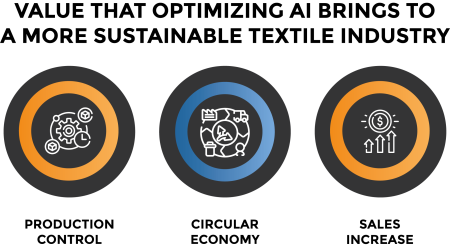Imagine a future where the textile industry reinvents itself to be sustainable and circular. The European Commission has launched a bold strategy requiring companies to produce durable and recyclable clothing, thereby reducing their environmental impact.Over 160,000 businesses face a pivotal change that will not only protect the planet but also unlock new business opportunities.
Discover how this revolution can be your competitive edge toward a greener and more prosperous future.

Horizon 2030: Sustainable textiles
The European Environment Agency estimates that 5.8 million tons of textile waste are discarded annually in Europe, including both post-consumer waste and production surpluses from textile companies. Additionally, the European Commission reports that every second, a truckload of textiles is either sent to landfill or incinerated.
Global textile production nearly doubled between 2000 and 2015, and clothing and footwear consumption is expected to increase by 63% by 2030.Given these production and consumption trends, the European Commission has released its strategy for textiles by 2030. The strategy outlines key pillars for the sector: sustainable, durable, and recycled fashion, which will require companies to better align their demand forecasts and resource usage.
This 2030 Strategy is part of the Green Deal and aims to reduce the environmental impact of the sector. According to the Commission’s data, it is the fourth most influential sector on climate change, only behind housing, food, and mobility.
Over 160,000 companies will face new regulations.
This new framework represents a significant change and also a source of opportunities for the more than 160,000 companies in the sector and the over 1.5 million workers employed within it. Some processes in the supply chain will be completely transformed, while others will need to adapt to this new environment.
The key actions of this new strategy are:
- Establish design requirements to ensure that textile products last longer and are easier to recycle, as well as requirements for minimum recycled content.
Implement clearer labeling and a digital passport. - Combat “greenwashing.“
- Address overproduction, overconsumption, and discourage the destruction of unsold textile products.
- Extend producer responsibility through an ecological modulation of fees.
- Tackle the unintended release of microplastics from synthetic textiles.
- Restrict the export of textile waste and promote sustainable textiles on a global scale.
- Encourage circular business models such as reuse and repair sectors.
Additionally, the European Commission has set out sanctions within this Green Deal for companies that fail to comply with the regulations. These sanctions can range from financial penalties and product bans to the loss of subsidies. There are also potential reputational damages associated with non-compliance with this Strategy.
To seize the opportunity presented by this new horizon, companies need to review their production processes, optimize supply chain stages to adapt to the circular economy, and apply technological innovation in their operations.
What are the advantages of operating within this framework?
Beyond the obvious reason of avoiding sanctions, there are other benefits that may be less apparent:
- Gaining a competitive edge by adapting ahead of competitors.
- Enhancing branding and corporate image.
- Taking advantage of financial support that the European Commission is expected to provide.
Technology becomes a crucial partner in making this possible. Implementing advanced predictive models and optimization AI in supply chain processes and production systems will be key to navigating the 2030 horizon.
Some of the most apparent applications of optimization AI in this new scenario include optimizing production levels to avoid overproduction and using AI tools to reduce costs in circular business models.

Production control
AI can assist us from two perspectives: by calculating the optimal production volume at each moment and facility based on advanced demand forecasting models and historical sales data, without neglecting demand, and by creating optimization models that address the variables introduced by this new framework. Optimizing the quantity of product supplied to the market could also improve margins by increasing sales at the best possible price and avoiding successive markdowns due to seasonality or end-of-season clearance, where margins are typically 100% negative.
Circular Economy
To maximize profitability in this approach, it is essential to achieve manageable costs for reverse logistics. AI can help optimize routes and product movements, thereby reducing the cost per item.
The contribution of optimization AI to increasing sales
This regulatory framework should not distract us from the core business goal of maximizing sales. AI can also support this aspect by optimizing product placement in both offline and online channels, distributing the most appropriate products to each store, and selecting prices that best match each store and region. The applications of optimization AI are numerous.

Act Better to Achieve Change
We now understand the challenges of a new context and know that there are technologies and actions we can adopt. It’s time to start the change.
Optimization AI is a powerful tool that can significantly aid in adapting to this new legislative framework, as it can be implemented across all links in the value chain. Read more about smart AI supply chain management in retail here
We are at a crucial moment to prepare for this change and contribute to environmental improvement while gaining a competitive edge over our rivals.
If you want to learn more about how to prepare for this new regulatory framework, you can book a free consultation with one of our experts. Start your journey with a strategic ally specializing in process optimization and optimization AI.



